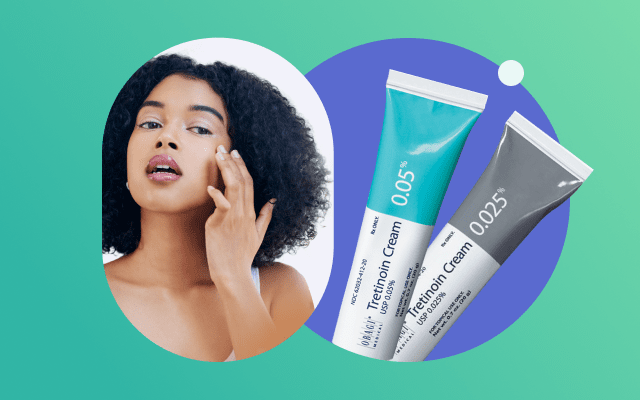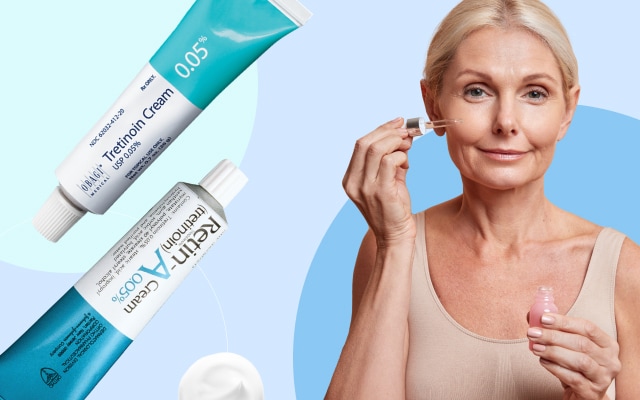Combining Niacinamide and tretinoin
Tretinoin and niacinamide complement each other when used together as part of an anti-aging or acne skin care routine. But can you get a customized formula in a bottle with both ingredients?
Table of Content:
Can you use them together? | How to get a prescription for niacinamide and tretinoin? | Where can you get a customized formula? | Benefits of using tretinoin and niacinamide together | What is niacinamide? | Benefits | What is tretinoin? | Benefits
Our commitment to producing high-quality content:
The information presented in this article is based on scientific research and the professional advice of our Content Medical Reviewers, who are experts in the field of Dermatology. How we write our content →
Dr. Alpana Mohta, board-certified dermatologist, niacinamide (vitamin B3) and tretinoin (a derivative of vitamin A) are both popular skincare ingredients, which have complementary benefits which is why it can be beneficial when used together.
Tretinoin (also known as all-trans retinoic acid) is well-known for increasing cell turnover, boosting collagen, treating acne, and diminishing the appearance of fine lines and wrinkles, but it can be quite irritating on the skin1.
Tretinoin is usually prescribed for mild to moderate acne, it addresses hyperpigmentation, refines rough skin textures by promoting cell turnover, and may improve the appearance of stretch marks. Furthermore, tretinoin plays a role in anti-aging, reducing fine lines and wrinkles by boosting collagen production and enhancing skin elasticity2 3 .
Niacinamide on the other hand, is a water-soluble vitamin that can help improve the skin barrier, reduce inflammation, lighten hyperpigmentation, and control oil production. It reduces enlarged pores, tightens slackened pores, enhances uneven skin tone, smoothes fine lines and wrinkles, combats dullness, and fortifies a compromised surface4.
Without protection, the skin can look aged, lackluster, and less radiant. Niacinamide acts as a protective shield for skin, also strengthening the skin’s barrier, its primary defense, mitigating environmental damage and aiding in the repair of cumulative harm caused to your skin by UV rays and lifestyle5.
If you want to learn more in depth about tretinoin, read our Tretinoin Guide for Patients by expert dermatologist Dr. Alpana Mohta.
Can you use tretinoin and niacinamide together?
Dr. Mohta says that yes, absolutely! You can use them as separate products because their synergistic effects offer multiple benefits for the skin. You can also request a single compounded formulation.
How to get a prescription for niacinamide and tretinoin?
For just $59, you can request a prescription for a blended formula that includes niacinamide and tretinoin. Simply spend a few minutes answering questions about your condition, upload skin photos, and specify the formulation you desire. Within 1-2 days, your online dermatologist will evaluate your information and issue your prescription.
Where can I buy a customized formula with niacinamide and tretinoin?
After consulting an online dermatologist in the Miiskin platform, they can issue a prescription for a customized formula for your skin and you can buy it at an online compounding pharmacy.
What are the benefits of using niacinamide and tretinoin together?
Reduced skin irritation
Tretinoin can be quite irritating to the skin, especially when it is first introduced into a skincare routine. Niacinamide’s anti-inflammatory properties can help counteract some of this irritation and dryness caused by tretinoin.
Addresses multiple skin concerns
Niacinamide and tretinoin can target acne, acne scars, dark spots, fine lines, wrinkles, uneven skin tone and texture at the same time.
Enhanced efficacy
The anti-inflammatory properties of niacinamide with the cell turnover benefits of tretinoin can provide enhanced results in addressing various skin concerns like acne, pigmentation, and signs of aging.
What is niacinamide and what is it used for?
Dr. Mohta says that niacinamide strengthens skin’s protective barrier, helps retain moisture, and promotes the production of proteins and ceramides. It also aids in skin cell development and boosts cellular energy levels.
Due to the many benefits it has on the skin, niacinamide is a widely used ingredient used in cosmetics for barrier repair, aging skin, pigment correction and acne. For aging skin, niacinamide smoothens wrinkles and refines surface texture. It also has anti-inflammatory properties, which help improve conditions like acne and rosacea6.
Benefits of niacinamide
Strengthens skin barrier
Niacinamide helps improve the skin’s barrier function, leading to decreased water loss and increased hydration7.
Reduces sebum production
Niacinamide can help regulate the production of sebum (oil), which can be beneficial for those with oily or acne-prone skin8.
Treats hyperpigmentation
Niacinamide can help treat hyperpigmentation, which means it can lighten dark spots and even out skin tone9.
Anti-aging properties
Niacinamide may help reduce the appearance of fine lines and wrinkles10.
Anti-inflammatory
Niacinamide has anti-inflammatory properties, which can help calm and soothe skin, making it beneficial for conditions like acne and rosacea11.
Anti-oxidant properties
Niacinamide offers protection against environmental stressors like pollution and UV radiation12 .
Improves skin texture
The regular use of niacinamide can lead to smoother skin with a refined texture13.
Reduced pore appearance
Niacinamide can help reduce the size of pores over time.
Side-effects of niacinamide
Dr. Mohta says that niacinamide is generally well-tolerated, especially in topical skincare products and it doesn’t tend to cause side effects besides a rare but possible allergic reaction.
What is tretinoin and what is it used for?
Tretinoin is a one of the best acne treatments there is and it belonging to the class of prescription retinoids. Tretinoin helps regulate different skin cells processes for example, how they develop and mature which is beneficial to manage different skin problems14.
Benefits of tretinoin
Anti-inflammatory
Tretinoin can help decrease the inflammation associated with acne lesions, reducing discomfort15.
Stimulates collagen production
Tretinoin inhibits collagenase, an enzyme that breaks down collagen fibers. Collagen supports the skin’s thickness, leading to a reduction in wrinkles with smoother and more youthful-looking skin16.
Stimulates cell turnover
Tretinoin accelerates the turnover of skin cells, which involves shedding the outermost layer of dead skin cells and replacing them with new ones revealing younger skin cells17.
Normalization of keratinization
Tretinoin helps regulate the process of keratinization which can lead to the formation of plugs within hair follicles, contributing to the development of acne breakouts18.
Improves pigmentation
Tretinoin helps lighten sunspots, and uneven skin tone19.
Side-effects of tretinoin
Common side effects include skin irritation, peeling, heightened sun sensitivity, dryness, redness, a tingling or burning sensation, potential hyperpigmentation in darker skin tones due to irritation, and an initial increase in breakouts, often called “tretinoin purging.”
For guidance on how to use tretinoin effectively and safely, please refer to our comprehensive ‘How to use tretinoin guide’.
Provider & Prescription Information
Miiskin connects patients with independent dermatologists who provide care through their private practices. Compounded prescriptions can be ordered via Miiskin and are dispensed by Foothills pharmacy. Standard medications can be issued for any local pharmacy.
References:
https://www.ncbi.nlm.nih.gov/pmc/articles/PMC3225141/
https://www.ncbi.nlm.nih.gov/books/NBK557478
https://pubmed.ncbi.nlm.nih.gov/17147561/
https://pubmed.ncbi.nlm.nih.gov/16766489/
https://pubmed.ncbi.nlm.nih.gov/12100180/
https://www.ncbi.nlm.nih.gov/pmc/articles/PMC6824628/
https://www.ncbi.nlm.nih.gov/pmc/articles/PMC2921764/
https://www.jwatch.org/jd199310010000004/1993/10/01/tretinoin-restores-collagen-formation-photoaged
https://pubmed.ncbi.nlm.nih.gov/1729619/





 Interested in getting a prescription for tretinoin and niacinamide?
Interested in getting a prescription for tretinoin and niacinamide?
